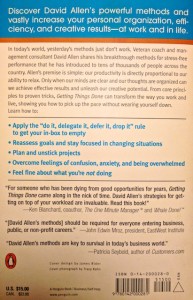
He claims stress can be reduced and productivity increased by putting reminders about everything one is not working on into a trusted system external to one's mind. A self-assessment is made of the emotions experienced after completing the steps of this process.The next step required to approach completion of the task is written down.A description of the successful outcome of the "incomplete" is written down in one sentence, along with the criteria by which the task will be considered completed.

The most annoying, distracting, or interesting task is chosen, and defined as an "incomplete".Allen calls these sources of stress "open loops", "incompletes", or "stuff". Themes Īllen first demonstrates stress reduction from the method with the following exercise, centered on a task that has an unclear outcome or whose next action is not defined. įirst published in 2001, a revised edition of the book was released in 2015 to reflect the changes in information technology during the preceding decade. This allows one's attention to focus on taking action on each task listed in an external record, instead of recalling them intuitively. The GTD method rests on the idea of moving all items of interest, relevant information, issues, tasks and projects out of one's mind by recording them externally and then breaking them into actionable work items with known time limits. Allen states "there is an inverse relationship between things on your mind and those things getting done".

GTD is described as a time management system. Getting Things Done ( GTD) is a personal productivity system developed by David Allen and published in a book of the same name.


 0 kommentar(er)
0 kommentar(er)
